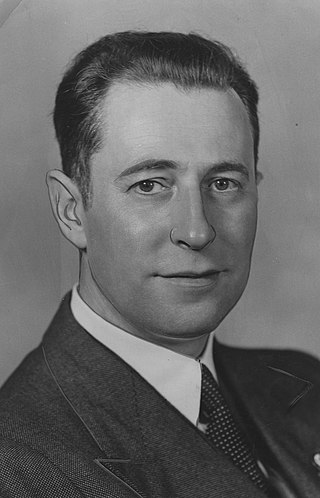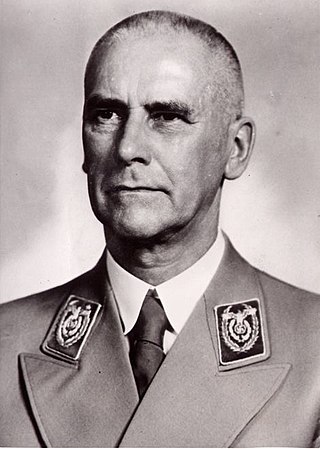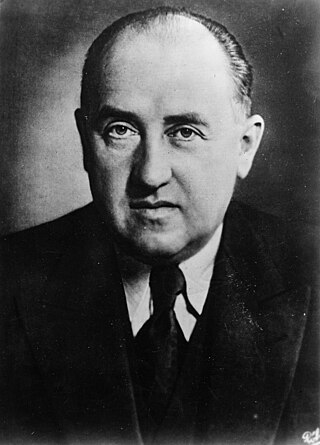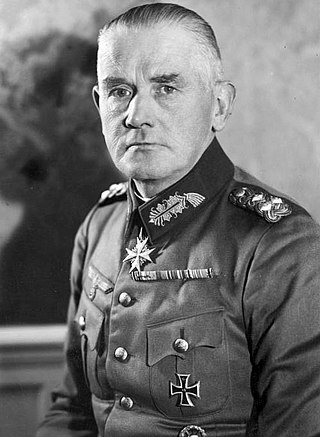Related Research Articles

Ulrich Friedrich-Wilhelm Joachim von Ribbentrop was a German politician and diplomat who served as Minister of Foreign Affairs of Nazi Germany from 1938 to 1945.

Alfred Josef Ferdinand Jodl was a German Generaloberst who served as the Chief of the Operations Staff of the Oberkommando der Wehrmacht – the German Armed Forces High Command – throughout World War II.

Wilhelm Bodewin Johann Gustav Keitel was a German field marshal who held office as chief of the Oberkommando der Wehrmacht (OKW), the high command of Nazi Germany's armed forces, during World War II. He signed a number of criminal orders and directives that led to numerous war crimes.

August Franz Anton Hans Fritzsche was the Ministerialdirektor at the Propagandaministerium of Nazi Germany. He was the preeminent German broadcaster of his time, as part of efforts to present a more popular and entertaining side of the Nazi regime, and his voice was recognised by the majority of Germans.

Wilhelm Frick was a convicted war criminal and prominent German politician of the Nazi Party (NSDAP) who served as Minister of the Interior in Adolf Hitler's cabinet from 1933 to 1943 and as the last governor of the Protectorate of Bohemia and Moravia.

Walther Funk was a German economist and Nazi official who served as Reich Minister for Economic Affairs (1938–1945) and president of Reichsbank (1939–1945). During his incumbency, he oversaw the mobilization of the German economy for rearmament and arrangement of forced labor in concentration camps. After the war he was tried and convicted as a major war criminal by the International Military Tribunal at Nuremberg. Sentenced to life in prison, he remained incarcerated until he was released on health grounds in 1957. He died three years later.

Konstantin Hermann Karl Freiherr von Neurath was a German diplomat and Nazi war criminal who served as Foreign Minister of Germany between 1932 and 1938.

Hanns Kerrl was a German Nazi politician. His most prominent position, from July 1935, was that of Reichsminister of Church Affairs. He was also President of the Prussian Landtag (1932–1933) and head of the Zweckverband Reichsparteitag Nürnberg and in that capacity edited a number of Nuremberg rally yearbooks.

Emil Dominik Josef Hácha was a Czech lawyer, the president of Czechoslovakia from November 1938 to March 1939. In March 1939, after the breakup of Czechoslovakia, Hácha was the nominal president of the newly proclaimed German Protectorate of Bohemia and Moravia.

Werner Eduard Fritz von Blomberg was a German General Staff officer and the first Minister of War in Adolf Hitler's government. After serving on the Western Front in World War I, Blomberg was appointed chief of the Truppenamt during the Weimar Republic. Following the Nazis' rise to power, he was named Minister of War and Commander-in-Chief of the German Armed Forces. In this capacity, Blomberg played a central role in Germany's military build-up during the years leading to World War II. However, by 20 January 1938, he was forced to resign after his rivals, Hermann Göring and Heinrich Himmler, presented Hitler with evidence that his wife had posed in the past for pornographic photos.
The Hossbach Memorandum is a summary of a meeting in Berlin on 5 November 1937 attended by German dictator Adolf Hitler and his military and foreign policy leadership in which Hitler outlined his expansionist policies. The meeting marked the beginning of Hitler's foreign policies becoming radicalised.

The Hitler cabinet was the government of Nazi Germany between 30 January 1933 and 30 April 1945 upon the appointment of Adolf Hitler as Chancellor of the German Reich by President Paul von Hindenburg. It was contrived by the national conservative politician Franz von Papen, who reserved the office of the Vice-Chancellor for himself. Originally, Hitler's first cabinet was called the Reich Cabinet of National Salvation, which was a coalition of the Nazi Party (NSDAP) and the national conservative German National People's Party (DNVP). The Hitler cabinet lasted until his suicide during the defeat of Nazi Germany. Hitler's cabinet was succeeded by the short-lived Goebbels cabinet, with Karl Dönitz appointed by Hitler as the new Reichspräsident.

Hans Heinrich Lammers was a German jurist and prominent Nazi Party politician. From 1933 until 1945 he served as Chief of the Reich Chancellery under Adolf Hitler. In 1937, he additionally was given the post of Reichsminister in the cabinet. During the 1948–1949 Ministries Trial, Lammers was found guilty of crimes against peace, war crimes, crimes against humanity, and membership in a criminal organization. He was sentenced to 20 years in prison in April 1949 but this was later reduced to 10 years and he was released early.

Otto Lebrecht Eduard Daniel Meissner was head of the Office of the President of Germany from 1920 to 1945 during nearly the entire period of the Weimar Republic under Friedrich Ebert and Paul von Hindenburg and, finally, under the Nazi government under Adolf Hitler.

The government of Nazi Germany was a totalitarian dictatorship governed by Adolf Hitler and the Nazi Party according to the Führerprinzip. Nazi Germany was established in January 1933 with the appointment of Adolf Hitler as Chancellor of Germany, followed by suspension of basic rights with the Reichstag Fire Decree and the Enabling Act which gave Hitler's regime the power to pass and enforce laws without the involvement of the Reichstag or German president, and de facto ended with Germany's surrender in World War II on 8 May 1945 and de jure ended with the Berlin Declaration on 5 June 1945.

Rudolf Walter Richard Hess was a German politician and a leading member of the Nazi Party in Nazi Germany. Appointed Deputy Führer to Adolf Hitler in 1933, Hess held that position until 1941, when he flew solo to Scotland in an attempt to negotiate the United Kingdom's exit from the Second World War. He was taken prisoner and eventually convicted of crimes against peace. He was still serving his life sentence at the time of his suicide in 1987.
The Council of Ministers for the Defense of the Reich was a six-member ministerial council created in Nazi Germany by Adolf Hitler on 30 August 1939, in anticipation of the invasion of Poland – which provoked the beginning of World War II – with the purpose of allowing the continuation of the Nazi government, especially in relation to the war effort, while Hitler concentrated on prosecuting the war. The council has been described as functioning as a "war cabinet," although this assessment is disputed.
The Reich Ministry for Church Affairs also sometimes referred to as the Reich Ministry for Ecclesiastical Affairs, existed in Nazi Germany from 1935 until 1945 under the leadership of Hanns Kerrl and Hermann Muhs and attempted to unify the churches and align them with the goals of National Socialism.
The Law on the Trustees of Labour was a measure enacted by the government of Nazi Germany on 19 May 1933 that established the office of Trustee of Labour to regulate labour relations in Germany. The law was repealed by the Allied Control Council Law No. 40 of 30 November 1946, effective 1 January 1947.
References
- ↑ Shirer, William (1960). The Rise and Fall of the Third Reich. New York: Simon and Schuster. pp. 308–309. ISBN 978-0-831-77404-2.
- ↑ Faber, David (2009). Munich, 1938: Appeasement and World War II. Simon and Schuster. pp. 72–73. ISBN 978-1439149928.
- ↑ Wistrich, Robert (1982). Who's Who in Nazi Germany. Macmillan Publishing Co. p. 218. ISBN 0-02-630600-X.
- ↑ Shirer, William (1960). The Rise and Fall of the Third Reich. New York: Simon and Schuster. p. 319. ISBN 978-0-831-77404-2.
- ↑ "Nazi Conspiracy and Aggression, Volume IV, Document 2031-PS, pp. 654-655" (PDF). Office of United States Chief of Counsel For Prosecution of Axis Criminality. 1946. Retrieved 17 May 2021.
- ↑ "Nazi Conspiracy and Aggression, Volume II Chapter XV, p. 108" (PDF). Office of United States Chief of Counsel For Prosecution of Axis Criminality. 1946. Retrieved 17 May 2021.
- ↑ Snyder, Louis L. (1976). Encyclopedia of the Third Reich. McGraw Hill Inc. pp. 110–111. ISBN 978-1569249178.
- ↑ "Nuremberg Trial Proceedings, Volume 9, p. 289". Lillian Goldman Law Library, Yale Law School. Retrieved 18 May 2021.
- ↑ "Nuremberg Trial Proceedings, Volume 16, p. 640". Lillian Goldman Law Library, Yale Law School. 24 October 1996. Retrieved 18 May 2021.
- ↑ "Nazi Conspiracy and Aggression, Opinion and Judgment, pp. 104-105" (PDF). Office of United States Chief of Counsel For Prosecution of Axis Criminality. 1947. Retrieved 18 May 2021.